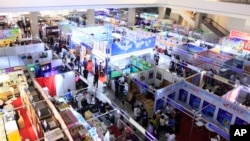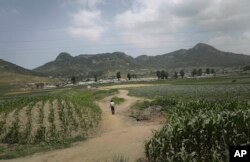What may seem like conflicting reports — that North Korea’s economy is growing while its people also face severe food shortages because of drought — underline the sharp divisions that exist in one of the world most isolated and repressive states.
“We have to understand that North Korea is a very unequal society,” said Go Myong-Hyun, a North Korea economic analyst with the Asan Institute for Policy Studies in Seoul.
Growing economy
According to the Bank of Korea in Seoul, the North’s economy grew last year by 3.9 percent, its fastest pace in 17 years despite international sanctions imposed for its nuclear and missile programs. Exports to China of coal and other minerals accounted for much of the increase.
However, this year China imported 54 percent less coal from North Korea. In March, Beijing banned further coal imports in response to U.S. President Donald Trump’s demand that China take stronger measures to restrain the Kim Jong Un government.
The Korea International Trade Association on Wednesday also reported that China’s exports to North Korea grew nearly 20 percent in the first half of the year, totaling $1.66 billion in outgoing trade. China’s exports of jet fuel to North Korea, while banned under U.N. sanctions, increased by 18 percent, and exports of mobile phones surged more than 90 percent.
The increased trade has disproportionately benefited a relatively small number of political and military elites that support the Kim government. They are reportedly provided with housing, prestigious jobs, and can afford to vacation at the Masikryong Ski Resort, built in 2013, dine at upscale restaurants in Pyongyang and buy international selections of alcohol and designer clothing.
A small number of elites even have unfettered internet access, including social media accounts such as Facebook and shopping sites like Amazon and Alibaba, while most North Koreans are prohibited from any contact with the outside world, according to Recorded Future, a security analysis company.
Edge of poverty
The vast majority of North Korea’s population of 25 million live in poverty, and according to a United Nations report this year, “chronic food insecurity, early childhood malnutrition and nutrition insecurity” continue to be widespread in the country, which ranks 98th out of 118 nations in the 2016 Global Hunger Index.
The U.N. Food and Agriculture Organization (FAO) recently issued a report warning that this year North Korea could experience one of the worst droughts since 2001.
“Immediate interventions are needed to support affected farmers and prevent undesirable coping strategies for the most vulnerable, such as reducing daily food intakes,” said Vincent Martin, FAO representative in China and North Korea in a statement.
Mitigating circumstances
For many, talk of food shortages in North Korea brings to mind the famines in the 1990s known as the “arduous march” that killed more than 3 million people. But analysts say conditions today are different and the likelihood of widespread starvation is very low.
North Korea has experienced other significant droughts (2012 and 2014) and floods (2006, 2007, 2012 and 2016) that affected food supplies but did not lead to widespread starvation.
Stephan Haggard, a North Korea analyst and visiting fellow at Peterson Institute for International Economics, recently wrote, “The FAO report has a somewhat alarmist tone, and the weather could still turn around.” Last week the Korean Peninsula experienced significant rainfall, and three typhoons are reportedly developing in the region.
Agriculture reforms permitting North Korean farmers to keep a percentage of what they produce and allowing families to cultivate small plots of land for private use have made people less reliant on inefficient government farming practices and more able to endure times of scarcity.
Politics of food
Sending food aid to an adversarial nation spending billions of dollars to build nuclear weapons and long-range ballistic missiles, in defiance of U.N. resolutions banning such development, is also a controversial issue. Go said the Kim Jong Un government could divert about $300 million from its nuclear program to import food to make up for any drought shortages.
“If they really wanted to fill the gap by importing food from outside, they could spend that amount of money easily, but they don’t do it because they can always have access to the NGOs (nongovernment organizations) and international organizations ready to provide them with free food assistance,” Go said.
In addition, there are concerns that North Korean officials could monetize food aid by selling it on the black market or exporting it to China.
Youmi Kim in Seoul contributed to this report.













